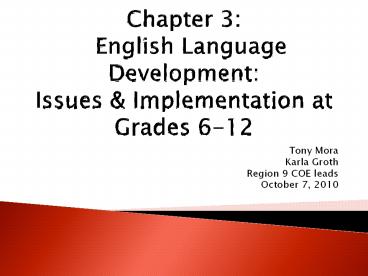Chapter 3: English Language Development: Issues - PowerPoint PPT Presentation
1 / 15
Title:
Chapter 3: English Language Development: Issues
Description:
Title: Chapter 3: English Language Development: Issues & Implementation at Grades 6-12 Author: kgroth Last modified by: Erin Mason Created Date – PowerPoint PPT presentation
Number of Views:92
Avg rating:3.0/5.0
Title: Chapter 3: English Language Development: Issues
1
Chapter 3 English Language DevelopmentIssues
Implementation at Grades 6-12
- Tony Mora
- Karla Groth
- Region 9 COE leads
- October 7, 2010
2
Rethinking English Language Instruction for
Adolescent English Learners5 points to consider
- A discussion of the linguistic challenges faced
by adolescent English learners - An overview of the diversity among English
learners in grades 6-12 standards-based English
proficiency levels - A rationale for instructed ELD in the secondary
context - An analysis of common course placements for
adolescent English learners the potential
shortcomings of these placements - A model for Instructed ELD in the secondary
school context.
3
I. Linguistic Challenges for Adolescent English
Learners
- Complex linguistic knowledge (p. 153)
- 6 Aspects
- Phonology
- Morphology
- Vocabulary
- Syntax
- Formal Informal Discourse Styles
- Academic Social Functions
4
I. Linguistic Challenges for Adolescent English
Learners (continued)
- Academic English
- The ability to apply general word knowledge
differently to a variety of subject areas - Gaps in Language Proficiency
- Many English learners develop oral fluency for
face to face communication, but cannot perform
task that require academic language proficiency
5
II. Diversity of Adolescent English Learners
- Adolescent English Learners come with a range of
experiences - Literacy and content knowledge in the primary
language - Previous experience in America Schools
- English language knowledge
- A one-size fits all approach will not work
particular attention needs to be paid to Long
Term ELs (p. 157)
6
III. A Rationale for Instructed ELD
- Adolescent English learners must have a competent
second language base if they are to be successful
in standards-based course work - To reach grade level standards, ELs need a
comprehensive approach which means explicit
English language instruction through out the
day. - Instructional this would include English as its
own content (ELD) supported by targeted
academic English instruction across the subject
areas (Dutro Moran 2003)
7
III. A Rationale for Instructed ELD(continued)
- ELD Instruction Language is in the foreground
and content is in the background. - Content Instruction Content is in the
foreground and language is in the background. - (p. 163-164)
8
Figure 3.2 Blueprint for Instruction of
Adolescent English Learners
English Language Arts Instruction English Language Arts Instruction English Language Arts Instruction Math, SS, Science, PE, Arts
Instructed ELD Reading Intervention Grade-Level ELA
Goal Develop a solid English language foundation needed to fully engage in academic and real-life situations. (p.165) Goal Gain literacy skills needed to accelerate achievement (for students currently performing below grade level) Goal Achieve grade-level content standards Goal Achieve grade-level content standards
Explicit Language Instruction For Content
Learning Purpose Teach language
needed Content Determined by lesson student
knowledge of English Teachers Need tools to
plan lang. content learning. Support through
collaborative planning
9
IV. Common Student Placements and Potential
Shortcomings
- English Language Development (ELD)
- Many adolescent ELs do not receive ELD support
once they have reached upper intermediate level
on the CELDT - Reading Intervention
- Often based on CST or placement test without
consideration for the English level or primary
language skills - Sheltered content area instruction
- Focus almost exclusively on access to the
core/content. Language learning often becomes
secondary or a non-existent part of instruction.
Opportunity to develop the skills for speaking
writing about the content is lost. - Special Education
- IEPs for English learners need to include
language proficiency goals.
10
V. A Model for Explicit Language Instruction
- Purposeful use of language identified in ELD
standards (language functions) - To perform Cognitive tasks
- To express thinking orally and in writing
- To inform text structure
- To engage in social and academic conversation
- Relevance to EL Instruction
- Participate in discussion
- Describe, explain, and elaborate
- Predict
- Express action and time relationships
- Draw Conclusions
- (Figure 3.3 p. 171)
11
V. A Model for Explicit Language Instruction
(continued)
- Language tools needed to accomplish these goals
(brick and mortar words) - What language tools are needed to communicate for
different purposes? - What language is needed to comprehend text and
express thinking orally and in writing? - Mortar-Functional words and phrases in sentences
structures - Would have liked to
- Are usually/tend to
- Bricks-Topic specific words
- Tree, elbow (basic)
- Debate, government, arid (general)
- War of Independence, incisor, germinate
(specialized) - (Figure 3.3 p. 171)
12
A Model for Explicit Language Instruction
(continued)
- Robust and contextualized instruction that
includes many opportunities to engage in language
practice (error free language language that is
easily produced) - How are language tools introduced, modeled, and
practiced using an I/We/You Do It approach? - What opportunities for structured interaction are
provided for students to practice the language
they are learning? - How are students supported in gaining oral and
written fluency? - (Figure 3.3 p. 171)
13
Think Write Pair Share
14
(No Transcript)
15
Q A































